Weekly Topics/Archive
October 2012
|
Once I am switched to “rekinan” mode, it's difficult to stop it right now.
(Note 1) Young men who are interested in Japanese history are called rekinan.
This time I went pottering around Yasu City.
Yasu City is located north of Kusatsu City and there are two cities, Moriyama and Ritto Cities, between
them.
The place where I would like to visit is a village associated with a Shirabyoshi, “Gio”, who appeared in
an NHK period drama titled “Taira no Kiyomori”.
When I visited Three Great Tendai Temples of Konan so called Konan Sanzan,
the other day,
I casually brought home a brochure from one of them.
It's a sightseeing brochure issued by the Tourism & Local Products
Association of Yasu City.
There are some articles about Gio-ji Temple in it and it's also within a reasonable distance from
my home to go pottering.
Today's cycling route is as below.
I left my home at 10 AM.
On the way, I took a break on the Ohmi-Fuji Ohashi Bridge over the Yasu
River.

The view toward lower reach of the Yasu River
from the bridge |
|
|
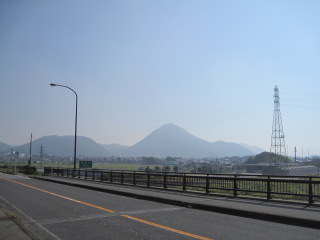
The view of Ohmi-Fuji (Mt.Mikami)
from the bridge
|
|
When I pedaled through an urban area near JR Yasu Station for several
minutes, I saw
a countryside stretching out before me.
And when I turned left at the Ebe intersection on the prefectural road
2,
I saw red and blue flags flying at proper intervals.
They lead me to Gio-ji Temple.
“Welcome to Yasu, the hometown of Gio and Gizyo.”
on the blue flags.
And “Thanksgiving for Gio and Kiyomori-san” on the red flags.
I arrived at a small temple, Gio-ji Temple around 10:15 AM.
It's in the village.
It was built by villagers at Gio's birthplace in order to pray to the Buddha
for her happiness.
Well then, who on earth was Gio ?
I will have to describe her in a little more detail.
Heike Monogatari (The Tale of the Heike) begins with “The sound of the
Gion Shoja bells echos
the impermanence of all things.”
The heartbroken episode about Shirabyoshi Gio was described in detail in
section 6 of the Volume
1, “Gio” of the tale.
A brief outline of section 6, “Gio” is as below.
There were two sisters, Gio and Gizyo, as Shirabyoshi who performed traditional
Japanese dances in ancient Kyoto.
They had a good reputation as Shirabyoshi.
Gio had been loved by Taira no Kiyomori and so had lived a good life.
Three years later, when a Shirabyoshi, Hotoke-gozen who was more prominent
and younger
than Gio visited Kiyomori's place, she was rejected by him.
But after Hotoke-gozen showed her dance to Kiyomori after an offer by
Gio, she began to
be loved by Kiyomori instantly.
And Gio was forced to leave Kiyomori because his affection changed to Hotoke-gozen.
After that, Gio became a nun with her sister Gizyo and her mother Toji
and entered
the Gio-ji Temple in Sagano.
By and by, Hotoke-gozen also followed her and became a nun.
They devoted themselves to Buddhism and died a peaceful death.
Reference;Brochure ; 「清盛・妓王ゆかりの祇王井川散策絵図」
(Published by the Tourism & Local Products Association of
Yasu City )
Note ;Shirabyoshi were female professional dancers who performed traditional
Japanese dances while singing songs and ballads called “Imayo” at
the
banquet from the late Heian period to the Muromachi period.
You can imagine Shirabyoshi with dancers who are dancing in the below
Ukiyoe
picture.

Ukiyoe picture「六波羅御所清盛公遊宴之図」(Owned by Gio-ji Temple) |
|
Generally speaking, Shirabyoshi Gio is known as an unfortunate woman abandoned
by Taira
no Kiyomori.
There is a legend about Gioi River in Yasu with the Tale.
It is described as below in the “A Brief History of Gioji Temple ”in 1776.
Gio was born in Ebe village, Yasu district in Omi Province.
She come to Kyoto to became a Shirabyoshi.and was loved by Taira no Kiyomori.
To save villagers who were suffering from a drought, Gio asked Kiyomoroi
to build
an irrigation channel in her hometown Yasu.
Villagers called Gioi River.
After her becoming to a nun, she devoted herself to Buddhism and died at
the 38 years.
To honor her contribution, Villagers built a temple and named it Gioji
Temple.
Reference;Brochure; 「清盛・妓王ゆかりの祇王井川散策絵図」
(Published by the Tourism & Local Products Association of Yasu City )
|
Gio has been respected as a great women who saved villagers.
It's because Gioi-gawa River which was built by Kiyomori owing to Gio is flowing through the city
as important water for agriculture even now over 800 years later.

Temple gate of Gioji Temple |
|
|
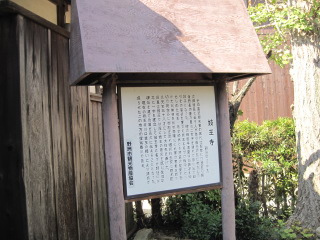
The guide plate about the origin of Gioji Temple |
|
Gioji Temple is a Jodo Buddhism temple.
The mountain name is Houchizan.
The principal image is Amida Nyorai.
Now it has not any priest and so is managed by village caretakers.
When I go through the temple gate, I can see the main hall on my left.
I was led by a local guide to enter the hall.
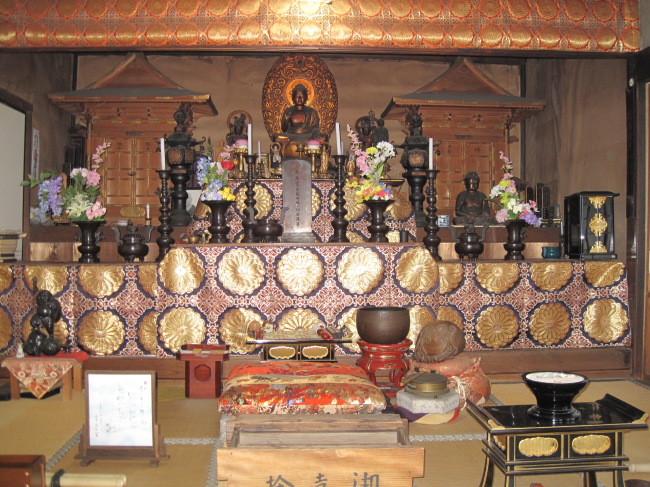
Buddhist alter of the main hall |
|
Watching the video, we received an explanation of Gio and Gioji Temple.
The content is as already mentioned.
I feel like I can almost hear the slow melody which hear repeatedly in the NHK period drama,
“Taira no Kiyomori”.
There are zushis (miniature shrines) on either side of seated Amidanyorai
statue in the center
of Buddhist alter.
In the left zushi, two wooden images of Gio and her sister Gizyo are enshrined.
And also in the right zushi, two wooden images of Hotokegozen and Gio's
mother Toji.
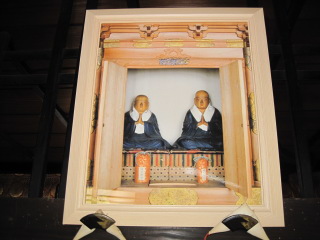
Gizyo(left) and Gio(right) in the left zushi |
|
|
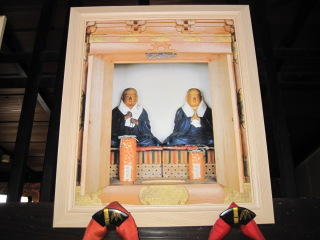
Hotokegozen and Toji in the right zushi |
|
There stand three stone pagodas in the temple ground.
Two on the left are pagodas for mourning Gio and Gizyo.
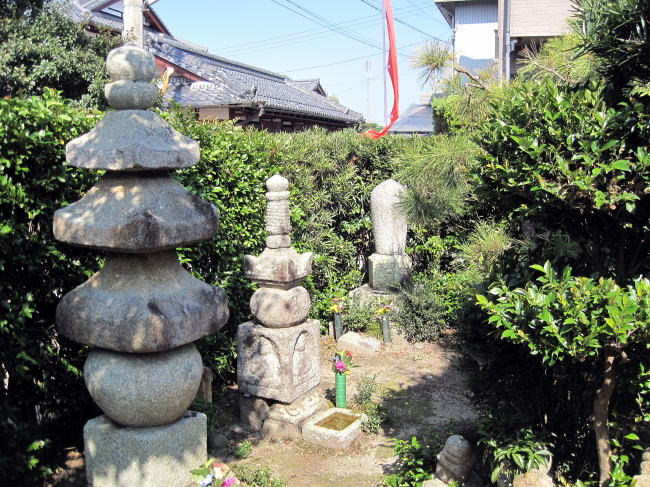
The stone pagodas in the temple ground |
There is the place where has been told to be remains of Gio's house near
Gioji Temple.
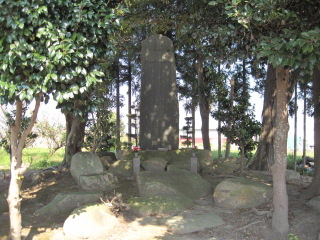
The remains of Gio's house and a monument to Gio |
|
|
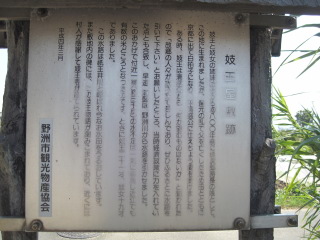
The Guide plate about the remains of Gio's house |
|
I have seen Gioigawa River which is still used even now.
According to the brochure, Gioigawa River is an irrigation canal, which
is about 12 km long
and takes its water from Yasu River.
It divides into two directions, east and west, behind Ikuwa Shrine in the
city.
They are called East Gioigawa River and West Gioigawa River.
After that, they meet Iemune River again and then flow into Nodaura of
Lake Biwa.
It's said that even now, about ten villages gain the benefits of the cannal.
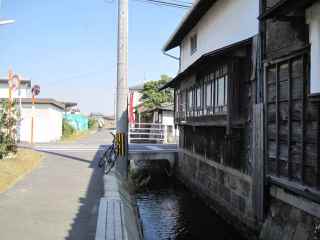
The east Gioigawa River |
|
|
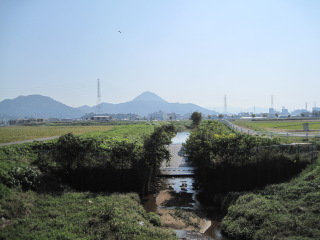
The west Gioigawa River
|
|
Even the cannal which run naturally through the countryside and the village has its own history, hasn't it?
When I was pedaling along the farm road after that, I happened to see this
sight.
The fields where were originally paddy fields were converted into soy fields by
governmental incentive scheme of rice-crop diversion.
I wish they were harvested.
In other words, farmers don't make their alibi for getting rice-crop diversion
subsidy, do you ?
If Gio saw such a scene, she might be very surprised.
I hope Japanese government implement adequate agriculture policies for the future.
I think it's much better for Japanese government to buy up their rice-crop
diversion fields
and make efficient use of them as potential land for mega solar power generation.
What do you think about it ?
On the way, I had a lunch break at a sushi restaurant in Yasu.
When I got to my home, it was 2:10 PM.
Today's cycling data are as below.
・Trip Distance ; 35.4 Km
・Elapsed Time ; 2 hours 18 minutes
・Average Speed ; 15.3 Km / hour
[Note] rekinan ; 歴男, be associated with 〜 ; 〜にゆかりのある
an NHK period drama ; NHK 大河ドラマ, Konan Sanzan ; 湖南三山、 casually ; 何気なく
Tourism & Local Products Association ; 野洲市観光物産協会
lower reach ;下流域, urban area; 市街地, stretch out ; 広がる
pray to the Buddha for one's happiness ;〜の菩提を弔う
on earth; (疑問を強調して)一体(全体), in detail; 詳しく、 The Tale of the Heike ; 平家物語
heartbroken; 悲哀にみちた、 echo the impermanence of all things ; 諸行無常の響あり
instantly ; 一気に, be forced to 〜;やむなく〜せざるを得ない、 become a priest (nun); 出家する
by and by ; やがて、しばらくして、 nun ; 尼僧、 devote oneself to 〜 ; 〜の道に励む、 〜に身をささげる
die a peaceful death ; 往生を遂げる、極楽往生する、 songs and ballads ; 歌謡
Imayo ; 今様, abandon; 見捨てる, legend; 伝説、drought ; 干ばつ
irrigation channel ; 用水路、 to honor one's contribution ; 〜の功績を称えて
water for agriculture ; 農業用水、 owing to 〜 ; 〜のおかげで、 Jodo Buddhism ; 浄土宗
principal image ; 本尊、 caretaker ; 世話人、 Buddhist alter; 仏壇、 zushi=miniture shrine ; 厨子
on either side of 〜; 〜の左右に, seated Amidanyorai statue; 阿弥陀如来坐像
stone pagoda ; 石塔、 mourn ; 追悼する、弔う、 remains ; 遺跡、跡、 farm road; 農道
convert into 〜; 〜に転換する, soy field; 大豆畑、 incentive scheme; 奨励制度
rice-crop diversion; 米から他の穀物への転作、 implement policy; 政策を実施する
make an alibi; アリバイを作る、 rice-crop diversion subsidy; 転作奨励金, buy up; 買い取る
mega solar power generation; メガソ−ラ発電
Japanese Diary / No.488−2012.10.22 / 「湖南ポタリング/平清盛と妓王ゆかりの里」 Diary / No.488−2012.10.22 / 「湖南ポタリング/平清盛と妓王ゆかりの里」
 TOPペ−ジへ戻る TOPペ−ジへ戻る
|
|